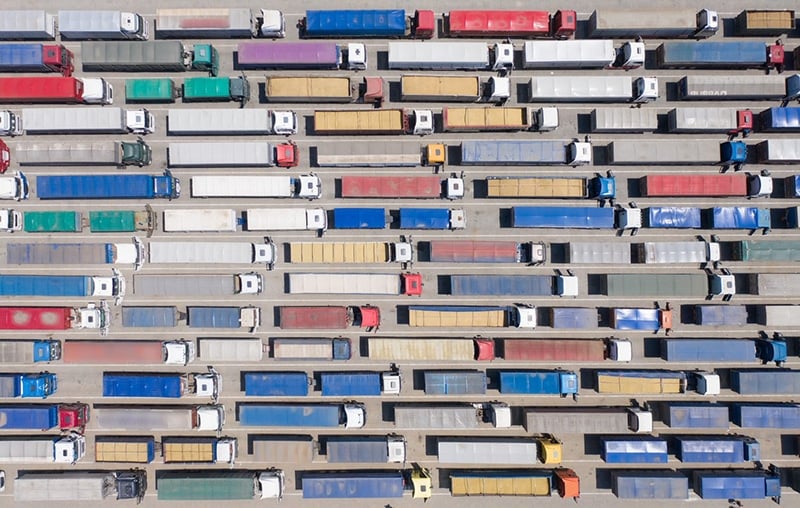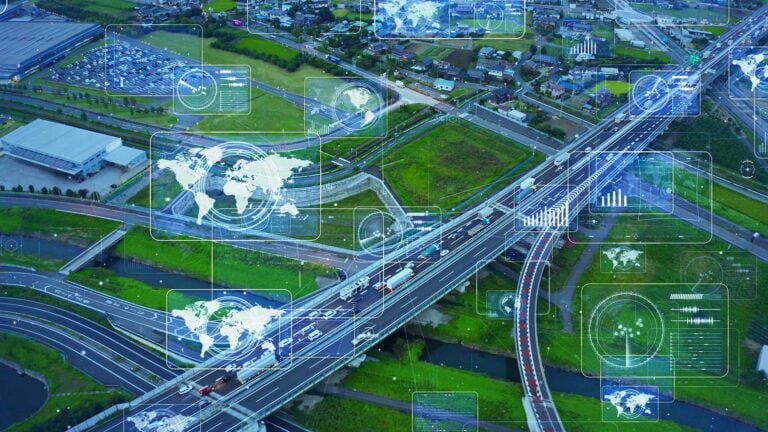In this article, we would like to analyze the links between digital transformation and environmental sustainability using the logistics industry as an example.
The current challenges facing the logistics industry
The widespread adoption of digital technologies over the past two decades has had a profound impact on our lives. The advent of online commerce has turned us into digital consumers who can source products from anywhere in the world and compare prices online in a matter of seconds. As a result, 85 million packages and documents are delivered around the world every day, driving the growth of the logistics industry.
 However, digital consumers have also become much more demanding than their predecessors. Increased customer expectations pose a difficult challenge for logistics companies, which have always suffered from significant inefficiencies. For example, between 25-50% of trucks worldwide still travel empty on our roads, mostly on the return trip after a delivery.
However, digital consumers have also become much more demanding than their predecessors. Increased customer expectations pose a difficult challenge for logistics companies, which have always suffered from significant inefficiencies. For example, between 25-50% of trucks worldwide still travel empty on our roads, mostly on the return trip after a delivery.
With more and more customers demanding deliveries within 24 hours, logistics companies are currently under intense time and price pressure. They are forced to improve their efficiency in order not to lose their profit margins. This trend is further reinforced by the entry of new technology companies into the industry, which are disrupting the sector with digital solutions.
So far, digital transformation has been the only solution found to this problem. In fact, 74% of transport companies consider digitalization as their biggest challenge for the coming years.
However, this is not their only critical challenge. The issue of sustainability is also becoming increasingly important in logistics. In 2016, this industry was the top emitter of greenhouse gas emissions in the U.S., accounting for 28.5% of total U.S. greenhouse gas emissions. In the same year, it accounted for about 38% of total CO2 emissions in Europe and 10% globally. So there is a lot of room for improvement, especially considering that 95% of the world’s transportation is powered by fossil energy.
Such reliance on petroleum-based fuels exposes the industry to fluctuations in oil prices, which remains one of the industry’s biggest vulnerabilities. The damage to the transportation sector is even greater, as this dependence on oil has made it a prime target for society’s growing environmental concerns.
Nevertheless, digital transformation is also the biggest opportunity for transportation companies: According to a World Economic Forum analysis, digital transformation is expected to add $1.5 trillion in value to logistics companies by 2025 and generate another $2.4 trillion in positive externalities for society.
The state of digital transformation in logistics
 Despite the slow progress, it would be a mistake to believe that the logistics industry has not made efforts to strategically deploy new technologies. In fact, there are a variety of technological innovations being used in logistics in different ways:
Despite the slow progress, it would be a mistake to believe that the logistics industry has not made efforts to strategically deploy new technologies. In fact, there are a variety of technological innovations being used in logistics in different ways:
- Autonomous forklifts can already be seen in many modern warehouses, airports, ports and other supply chain locations. Brands like Mercedes and Volvo are currently pioneering digital trucks. According to the World Economic Forum, autonomous trucks will have a $30 billion economic impact on the industry over the next decade due to savings in fuel costs, maintenance costs, labor costs, and insurance costs;
- 75% of German logistics companies believe the vast majority of warehouses will adopt data glasses before the end of the next decade;
- Blockchain has been cited numerous times as a solution to improve the customer experience by providing greater transparency and security for customers;
- Artificial intelligence and advanced analytics have tremendous potential to radically transform the logistics vertical, given the importance of supply chain resilience and the Internet of Things’ ability to enable companies to collect even more data for insightful, real-time analytics;
- New business models are emerging thanks to the success of new internet platforms that enable startups and small businesses to sell their products and services globally and improve supply and demand matching.
Digital transformation in logistics comes with a long list of potential improvements along the entire value chain. The benefits that logistics companies can derive from digitalization range from cost reductions in inventories to complete transparency in real time along the value chain. Digital transformation enables networked processes and decentralized, autonomous management and favors the introduction of elastic logistics, which implies improved company responsiveness to market conditions.
Big Data analytics is currently the area that offers the greatest competitive advantage, as it enables better decision-making and has high optimization potential, which generally translates into lower costs, higher profit margins, and more cost-effective, environmentally friendly operations. In its report on the digital transformation of logistics, the World Economic Forum specifically encourages companies to improve their data collection throughout the value chain and ensure they are able to analyze big data streams and use all this information to improve operational efficiency and introduce new services, such as last-mile delivery.
Despite some early adopters and forward-thinking companies, the majority of logistics companies are still lagging behind in digital transformation. Only a few companies have developed concrete strategies for the introduction of new technologies.
 However, as we have already seen, this low adoption is not due to a lack of interest in the technology. In some cases, there are legitimate doubts about the practicality of certain solutions; in others, the technologies are not fully understood. Regardless, the problems are rarely rooted in the technology itself. Rather, it seems that transit agencies do not feel ready.
However, as we have already seen, this low adoption is not due to a lack of interest in the technology. In some cases, there are legitimate doubts about the practicality of certain solutions; in others, the technologies are not fully understood. Regardless, the problems are rarely rooted in the technology itself. Rather, it seems that transit agencies do not feel ready.
The main obstacles are often a lack of regulations or very restrictive regulations, and an inability of the various stakeholders to work together and trust each other. For example, in most Big Data analytics applications, data sharing among supply chain players could be much smoother if they agreed on a common standard and on how to handle data security.
Nonetheless, logistics service providers (LSPs), freight forwarders, courier/express/parcel delivery (CEP) companies and all others in the logistics industry need to drive their digital transformation if they are not to expose themselves to life-threatening risks. Those that are able to develop tailored transformation strategies will survive in the market; those that do not adapt quickly enough will perish.
How digital transformation in logistics affects the industry’s environmental sustainability
Logistics contributes about 10% of global emissions, and its impact continues to grow as more goods are traded around the world. The World Economic Forum report raises some important questions about the future of logistics. One of these questions relates directly to the enormous impact this industry has on the environment:
 “Given the COP21 agreement in Paris, how can industry players quickly agree to develop safer and more trustworthy approaches to greener technologies like autonomous trucks and drones?”
“Given the COP21 agreement in Paris, how can industry players quickly agree to develop safer and more trustworthy approaches to greener technologies like autonomous trucks and drones?”
The question is as critical as it is complex, and the report limits itself to highlighting the problem without proposing solutions. However, given the growing interest in sustainability issues in business and society at large, several organizations have attempted to answer this fundamental question.
Accenture estimates that digital transformation could reduce the logistics industry’s emissions of pollutants by up to 3.6 billion tons by 2025. That’s a 10% reduction over a ten-year period. However, they also emphasize that we have not yet found a way to break the link between economic growth, emissions growth and resource consumption. If current business practices are not adjusted, there will be an 8 billion ton gap between supply and demand for natural resources globally by 2030. In financial terms, this translates into a loss of $4.5 trillion in economic growth by 2030.
Sustainability in logistics is therefore not just a question of ethics. It also has a critical economic impact. As more and more executives recognize this, more and more companies are declaring sustainability as one of their top priorities. Unfortunately, in most cases, these declarations are not followed by strategic action.
However, there are some examples of successful sustainability initiatives, and many are linked to new digital technologies. New business models such as green and reverse logistics, where circular economy principles are applied to logistics, are now easier to adopt thanks to returns management apps and automated inventory solutions. New platforms such as Saloodo! are helping to improve the overall efficiency of a supply chain by cutting out unnecessary middlemen, reducing both the cost and environmental impact of transportation. Telematics applications, the integrated use of telecommunications and informatics for in-vehicle applications, improve driver behavior and route optimization, reducing the environmental impact of the transportation industry.
Some companies are realizing tremendous business benefits by leveraging new digital technologies such as the Internet of Things, advanced robotics, and advanced Big Data analytics to improve their collaboration with supply chain stakeholders. Transportation capacity sharing has emerged as a critical strategy for reducing greenhouse gas and other emissions and mitigating the transportation sector’s impact on climate change. Sharing warehouse space leads to better value for money and reduces road miles by increasing delivery density. Companies such as 3M EMEA have achieved cost reductions of up to 35% and a 50% lower carbon footprint thanks to this collaborative approach.
The Internet of Things (IoT) enables asset tracking and tracing to identify optimized patterns and potential failures in the supply chain, which also contributes to logistics companies’ CSR initiatives. Big Data analytics and artificial intelligence provide companies with the knowledge and insights to reduce freight costs and better match supply and demand for underutilized assets and products. Combined with machine learning, these technologies also enable decentralized, autonomous decision making. With Big Data, providers can improve performance and minimize risk. In the maritime logistics industry, using data to optimize ship speeds and routes can reduce waiting times at ports and thus CO2 emissions.
Conclusion: Digital transformation in logistics promotes sustainability. But is it enough?
Sustainability issues and new digital technologies are undoubtedly changing the world of logistics. Those who refuse or fail to consider the environmental impact of their operations or implement a digital transformation process are exposing their companies to life-threatening risks. Although the logistics industry still has many steps ahead to become a modern, digital and environmentally friendly industry, the evolution has already begun. The business benefits of digitization, digitalization and green logistics on the one hand, and societal pressure to reduce the negative externalities associated with transportation on the other, make this process of change irreversible.
 While both are radical changes, they are mutually reinforcing. New digital technologies can significantly impact the environmental impact of logistics in a number of ways, directly or indirectly. Every leader should consider which technologies are best suited for their business and develop a digitization strategy that will help reduce their environmental footprint.
While both are radical changes, they are mutually reinforcing. New digital technologies can significantly impact the environmental impact of logistics in a number of ways, directly or indirectly. Every leader should consider which technologies are best suited for their business and develop a digitization strategy that will help reduce their environmental footprint.
However, there are still many barriers to the adoption of new digital tools in logistics. Information and communication technology can be perceived as too complex and sometimes requires collaboration with other players in the industry, which can still be a challenge. However, executives often cite lack of funding as the main reason for the absence of digital transformation initiatives.
This is partially true, as overvalued forecasts and high price volatility make it difficult for logistics companies to manage cash flows. However, while an initial short-term investment is definitely required, the long-term savings from sustainability practices far exceed their initial cost.
One way to address this problem would be through government incentives and subsidies. For example, companies could be asked to pay for a portion of their external costs while receiving money when they invest in new, greener digital technologies. Government regulations and policies that provide economic incentives, either for digital transformation initiatives or sustainability measures, could really impact the logistics industry.
Unfortunately, there are some drawbacks to this solution. The biggest drawback is that it takes a relatively long time for regulations to change, especially in areas like energy and fuels where companies are known to invest a lot of resources in lobbying. In addition, it has already been pointed out that certain regulations are currently blocking the diffusion of some technologies in the industry, suggesting that policymakers may not yet be ready to actually solve this problem.
In summary, climate change requires swift and collective action, and policies and regulations may not be the best way to promote digital transformation and sustainability in logistics. While there is no doubt that digital technologies can help us fight climate change, only the future will tell if the digital transformation of global logistics will happen fast enough to win the battle.









